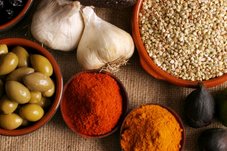Mise en Place Part 1, The Recipe
Mise en place is the culinary term used for all of the preparation needed to do in advance of actual cooking. Literally it means to put in place or to have everything in its place. It begins with the recipe.
Technically speaking, a recipe is a set of instructions for producing a certain dish in order to duplicate a desired preparation. Its purpose then is to have a precise record of ingredients, their amounts and the way in which they are combined. Generally a recipe contains at minimal the information such as the name of the recipe, the yield, the ingredients and the amounts to be used, directions and cooking times.
In my years spent in teaching in culinary academia students the first thing to be blamed for the failure of a dish was the recipe. Granted there are recipes that do not work either from misprints, editing error or not being accurately tested. Recipes for baked goods are much more sensitive to this as baked goods depend on precise combination of ingredients. There are numerous other factors however that can attribute to a recipe not working.
No matter how detailed a written recipe is the recipe can’t tell you everything. Cooking with some modicum of judgment is required. The difference between and experienced cook and a novice is the ability to make judgments about certain variables.
Food products are not uniform. Age, size, variety, degree of ripeness, brand, thickness, etc. are examples of ingredient variation.
Kitchens do not have the same equipment. Ranges and ovens each have their own temperament and pot and pans can vary according to the material used for construction, size, conductivity and thickness.
It is impossible to give exact instructions for many processes. What is moderate heat? What is cook until tender? How thick is a thick sauce? It is also important to understand that cooking times given in a recipe are relative and depend on a numerous number of factors. It is up to the cook to learn when a food is done. Cooking times given in recipes with exception are meant as a guideline. This is why when students ask me how long to cook something I generally reply, tongue-in-cheek, “‘til it’s done.”
Before you embark on making a recipe for the first time read through it thoroughly once, twice and three times. As you study the recipe apply your knowledge and think about the recipe in relation to the skills that you have. Access the basic cooking methods involved. Are you familiar with the technique of the method or do you need to find out more? What are the characteristics and the functions of the ingredients being used? What are the relative cooking times?
The more knowledge and experience you possess the easier it will become and you will know when you can make substitutions, alterations